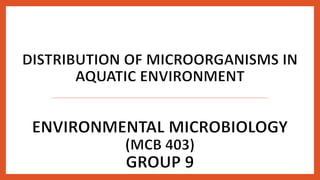
mcb 403 ppt g9.pptx
- 2. •The distribution of microorganisms in aquatic environments is a complex and dynamic process influenced by various physical, chemical, and biological factors. Aquatic environments include oceans, seas, lakes, rivers, ponds, and even smaller bodies of water like puddles and water-filled cavities. •Microorganisms in aquatic environments play crucial roles in nutrient cycling, food webs, and ecosystem functioning. Understanding their distribution is essential for studying aquatic ecology and environmental management.
- 3. MICROORGANISMS OF AQUATIC ENVIRONMENT Microorganisms inhabit surface waters in all zones; they may be suspended (plankton), cover fixed submerged objects, plants, etc. (periphyton), or reside in sediments at the bottom (benthos). 1. Plankton • Plankton or bioseston refers to the group of organisms that passively float in water without the ability to resist the movement and flow of water mass. These are classified as follows: a. Phytoplankton . Zooplankton Protozoa plankton • heterotrophic bacteria plankton, Virus plankton 2. Periphyton • Periphyton inhabits coastal zones. They are a collection of creatures that attach themselves to various objects and aquatic plants. • Typically, they consist of microscopic algae, such as diatoms, green algae, and bacteria
- 4. 3. Benthos • The benthos are a collection of species that inhabit the bottom environment. • The mucky bottom includes an abundance of organic chemicals produced by decomposition of dead materials (fallen parts of plants and animals). 4. Bacteria Bacteria, some of the smallest and oldest organisms on the planet, are prevalent in all water systems and practically every environment. Many bacteria wash into rivers and streams from the surrounding land, and their numbers can grow substantially after a rainfall The metabolic capabilities of bacteria are the most diverse of any group of species. Both heterotrophic and autotrophic microorganisms exist. In aquatic systems, heterotrophic bacteria play a significant role in the breakdown of organic materials and the cycling of nutrients.
- 5. 5. Fungi • Fungi consist of solitary cells and filaments known as hyphae. The majority of aquatic fungi are tiny, with hyphomycetes being the most abundant and significant. • As with heterotrophic bacteria, fungus receive their nutrition by secreting • Fungi play a crucial role in the decomposition of plant matter in aquatic systems, as they are among the only creatures capable of decomposing plant structural components such as cellulose and lignin. 6. Protozoa • Protozoa are small, unicellular organisms that occasionally form colonies. • Protozoa come in both autotrophic and heterotrophic varieties. In contrast to bacteria and fungi, heterotrophic protozoa (such as amoebas and Paramecium) devour other species, including algae, bacteria, and other protists.
- 6. 7. Algae • Several types of predominantly autotrophic protists are known as algae. As with the term “microorganisms,” it is a colloquial phrase used for convenience to refer to microorganisms that carry out photosynthesis; cyanobacteria are frequently categorised as algae.
- 7. Understanding their distribution is essential for studying aquatic ecology and environmental management. Which are: 1. Physical Factors: Temperature: Microbial distribution is influenced by temperature since different species have specific temperature ranges in which they thrive. For example, some bacteria may prefer cold waters in polar regions, while others are adapted to warm tropical waters. 2. Chemical Factors: • Nutrients: The availability of nutrients like nitrogen, phosphorus, and carbon significantly impacts microbial distribution. Nutrient-rich areas, often associated with runoff from land or upwelling in oceans, can support high microbial productivity.
- 8. 3. Water Movement: Currents: Water currents can transport microorganisms over long distances, leading to the dispersal of species and influencing their distribution patterns. Mixing: Vertical mixing in oceans and lakes due to wind or other forces can affect microbial distribution by changing nutrient availability and light exposure. 4. Biological Interactions: Competition: Microorganisms compete for resources, and this competition can affect their distribution patterns. Dominant species may outcompete others in certain niches. Predation: Grazers and predators can control the abundance of certain microorganisms. For instance, protozoa may consume bacteria, affecting bacterial populations.
- 9. 5. Habitat Specificity: Benthic vs. Pelagic: Microorganisms can be found in different habitats within aquatic environments. Benthic microorganisms live in or on the sediments at the bottom, while pelagic microorganisms live freely in the water column. Zonation: Microbial communities can exhibit zonation based on depth or other physical factors, leading to distinct communities at different water depths. 6. Human Impact: Pollution: Pollution from human activities can disrupt microbial communities. Nutrient runoff, industrial waste, and oil spills can lead to harmful algal blooms or alter microbial community structures. Climate Change: Changes in temperature, ocean acidification, and sea-level rise due to climate change can impact microbial distribution and alter ecosystem dynamics.
- 10. Overall, the distribution of microorganisms in aquatic environments is a complex interplay of physical, chemical, and biological factors. Studying these factors can help us better understand aquatic ecosystems and their responses to environmental changes.